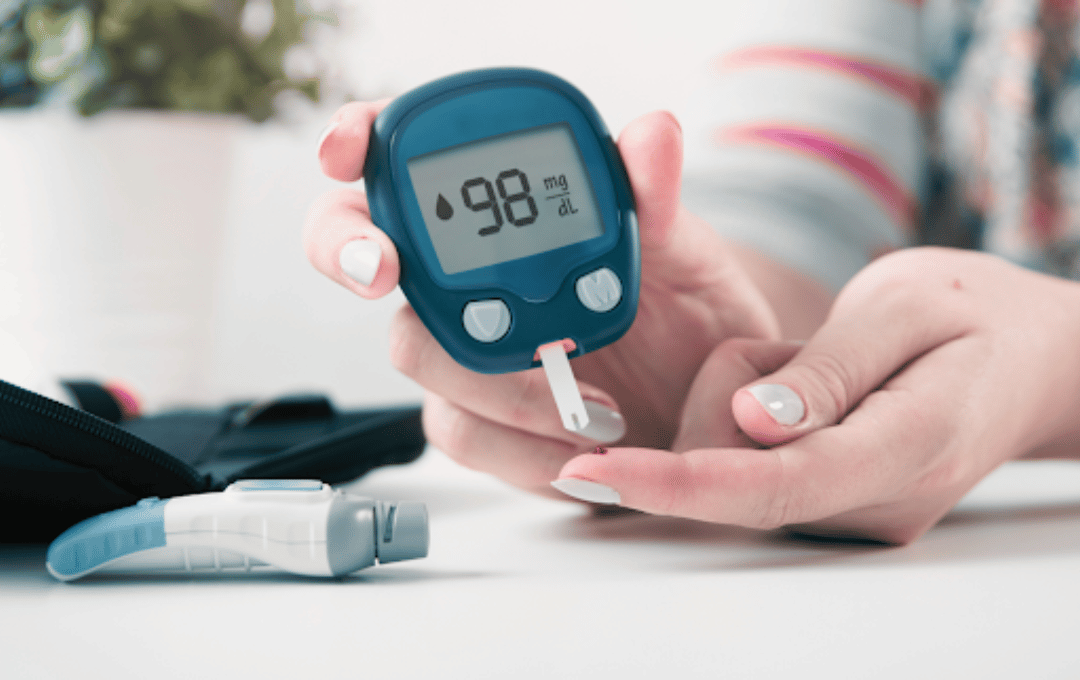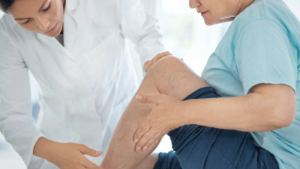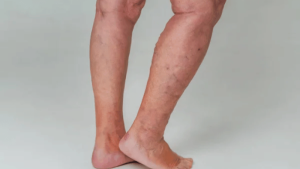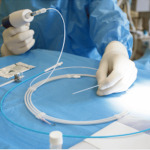
Diabetes, a chronic condition affecting over 100 million people, can significantly impact vein health. While over 30 million suffer from venous insufficiency – a condition where blood doesn’t circulate properly in the veins-only about ten percent seek treatment.¹
When blood sugar levels are consistently high, it can damage the body’s blood vessels, including those in the legs. This damage can weaken the vein walls, leading to conditions like varicose veins and venous insufficiency. Additionally, diabetes can impair nerve function, making it harder to notice early signs of vein disease, such as leg swelling or pain.
While diabetes can contribute to these issues, it’s important to note that it’s not the sole cause of vein disease. Many factors, including genetics, age, pregnancy, and prolonged standing or sitting, can contribute to the development of vein problems.
So, what is the connection between diabetes and varicose veins? Why are varicose veins a common problem among diabetics, and what can people with diabetes do to protect their vein health?
Varicose Veins and Diabetes
Varicose veins are swollen veins that become stretched over time due to damaged vein valves.
Vein valves usually act as one-way doors, moving blood from the lower parts of the body back to the heart. Valves that don’t work correctly can’t effectively move blood flow upward, leading to blood and other fluids pooling in the legs. As a result, leg veins are enlarged, and symptoms like leg heaviness and calf cramping follow. This condition is called venous insufficiency or vein disease.
Untreated venous insufficiency can cause varicose veins, leading to leg swelling, cramping, itching, fatigue and potentially more severe issues like pain, ulcers, deep vein thrombosis (DVT) and weakened immunity later on.
People with diabetes are at an increased risk for vein disease. This is because high blood sugar levels can damage the walls of veins and make them more likely to leak and pool. Additionally, people with diabetes often have nerve damage, which can make it difficult to feel pain in the feet and legs. This can lead to delays in seeking treatment for foot ulcers, leading to serious complications, such as amputation.
Venous insufficiency and diabetes share some of the same risk factors, like obesity and high blood pressure, so it’s not uncommon for someone to have both diabetes and varicose veins.
How Diabetes Impacts Vein Health
Diabetes can significantly harm vein health. High blood sugar levels damage blood vessels, leading to plaque buildup and hardening of the arteries. This narrows and stiffens blood vessels, raising blood pressure and damaging vein valves and walls. The veins become damaged because they have to work harder to pump blood back toward the heart.
Chronic inflammation, often associated with diabetes, further contributes to vein damage, causing varicose and spider veins. Nerve damage, also linked to high blood sugar, can mask symptoms of vein disease, delaying diagnosis and treatment.
One of the most common complications of diabetic vein disease is varicose veins. Varicose veins are enlarged, twisted veins that can appear on the legs and feet. They are caused by blood pooling in the veins, which can damage and weaken the vein walls. Varicose veins can be unsightly and painful, putting extra pressure on the body’s immune and circulatory systems.
If you have diabetes, it is important to know the signs and symptoms of vein disease. These include leg pain, swelling, varicose veins, spider veins, and skin color or temperature changes in the legs and feet. If you experience any of these symptoms, it is important to see a doctor. Early diagnosis and treatment of vein disease can help prevent serious complications.
Why People with Diabetes Are at a Higher Risk for Vein Disease
People with diabetes are at a higher risk of developing vein disease due to several factors:
1. Damage to Blood Vessels:
- High blood sugar levels can damage the blood vessels gradiaually, weakening the vein walls.
- This damage can lead to poor blood circulation, increasing the risk of varicose veins and other venous disorders.
2. Nerve Damage (Neuropathy):
- Diabetic neuropathy can reduce sensation in the legs and feet, making it difficult to notice early signs of vein disease, such as pain, swelling, or skin changes.
- This delay in diagnosis can lead to more severe complications.
3. Reduced Blood Flow:
- Diabetes can affect blood flow to the legs, making it harder for blood to circulate properly. This can contribute to the development of venous insufficiency and varicose veins.
4. Inflammation:
- Chronic inflammation is associated with both diabetes and vein disease. This can worsen the symptoms of both conditions.
5. Obesity:
- Obesity is a common risk factor for both diabetes and vein disease. Excess weight can strain the veins, increasing the risk of varicose veins and other complications.²
By understanding these risk factors, people with diabetes can take steps to reduce their risk of developing vein disease. Regular check-ups with a healthcare provider, maintaining healthy blood sugar levels, and adopting a healthy lifestyle can help prevent and manage vein disease.
How to Protect Your Vein Health if You Have Diabetes
These are some of steps an individual with diabetes can take to improve blood circulation:
- Avoid being sedentary. If you need to sit or stand for long periods, such as during work or traveling, try to get up and move around every hour.
- Wear compression stockings. These can help support your leg veins, pushing blood upward.
- Eat foods that improve circulation. Green leafy veggies, ginger, and berries can all help aid circulation. It’s also wise to avoid foods high in sugar, such as sweet treats and packaged snacks, and those that can lead to high blood pressure, like fried or high-fat foods.
- Manage your blood sugar levels effectively.
- Exercise regularly for at least 30 minutes most days of the week.
- Quit smoking.
- Get regular checkups and screenings from your doctor.
While these lifestyle changes can have a significant impact, it’s also important to regularly visit a vein specialist if you are diabetic or pre-diabetic, as diabetes and vein damage can prove to be a dangerous combination. A vein doctor can assess your vein health and provide a personalized treatment plan to help maintain healthy veins.
Early detection and treatment of vein disease is the best practice for improved circulatory health. It can also help prevent future complications, especially in diabetics.
Schedule Your Consultation Today
Varicose Vein Treatment at USA Vein Clinics
Our nationwide clinic locations offer a range of minimally invasive outpatient vein treatments that address damaged veins, the root cause of varicose veins. Varicose vein treatments offered at our location nationwide include:
- Endovenous laser vein treatment (EVLT)
- Varithena vein treatment
- Ultrasound-guided sclerotherapy
- Clarivein
- Venaseal
- Radiofrequency ablation (RFA)
If you have diabetes and are concerned about your vein health, we welcome you to schedule a consultation with a specialist at a USA Vein Clinic near you. Our experienced doctors can help you protect your veins and offer guidance on keeping them healthy as a diabetic.
Frequently Asked Questions
Are varicose veins a sign of diabetes?
Varicose veins are not a sign of diabetes. But the two conditions are related. They have similar risk factors — high blood pressure and obesity. Diabetes and high blood sugar can also cause vein damage, which can lead to varicose veins, so it’s important to see a vein doctor to screen for vein issues if you have diabetes.
Can diabetes cause varicose veins?
Diabetes doesn’t directly cause varicose veins, but it can increase one’s risk and negatively impact vein health.
Can diabetes cause deep vein thrombosis (DVT)?
Diabetes can increase the chances of developing a dangerous blood clot, including deep vein thrombosis — a blood clot in a deep vein.
Why is Vein Disease a Risk Factor for Diabetics?
Vascular disease, which refers to any condition that affects your circulatory system, including arteries, veins, and lymph vessels, is one of the more severe complications of diabetes. When too much glucose is circulating in the blood, it damages blood vessels, leading to vascular diseases, including vein disease. Vascular Disease includes varicose veins, diabetic macular edema (DME), nephropathy, atherosclerosis, and peripheral artery disease PAD.
Sources
- Runyan Liu, et al., “The impact of diabetes on vascular disease: Progress from the perspective of epidemics and treatments,” Journal of Diabetes Research, https://doi.org/10.1155/2022/1531289
- Carolyn T Bramante, Clare J Lee, & Kimberly A Gudzune, “Treatment of obesity in patients with diabetes,” Diabetes Spectrum, https://doi.org/10.2337/ds17-0030









